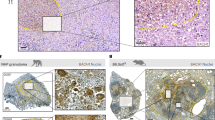Abstract
Interactions between Bacillus anthracis (B. anthracis) and host cells are of particular interest given the implications of anthrax as a biological weapon. Inhaled B. anthracis endospores encounter alveolar macrophages as the first line of defense in the innate immune response. Yet, the consequences of this interaction remain unclear. We have demonstrated that B. anthracis uses arginase, inherent in the endospores, to reduce the ability of macrophages to produce nitric oxide (•NO) from inducible nitric oxide synthase (NOS2) by competing for l-arginine, producing l-ornithine at the expense of •NO. In the current study, we used genetically engineered B. anthracis endospores to evaluate the contribution of germination and the lethal toxin (LT) in mediating signaling pathways responsible for the induction of NOS2 and ornithine decarboxylase (ODC), which is the rate-limiting enzyme in the conversion of l-ornithine into polyamines. We found that induction of NOS2 and ODC expression in macrophages exposed to B. anthracis occurs through the activation of p38 and ERK1/2 MAP kinases, respectively. Optimal induction of NOS2 was observed following exposure to germination-competent endospores, whereas ODC induction occurred irrespective of the endospores’ germination capabilities and was more prominent in macrophages exposed to endospores lacking LT. Our findings suggest that activation of kinase signaling cascades that determine macrophage defense responses against B. anthracis infection occurs through distinct mechanisms.


Similar content being viewed by others
References
Baillie L, Hibbs S, Tsai P et al (2005) Role of superoxide in the germination of Bacillus anthracis endospores. FEMS Microbiol Lett 245:33–38
Baldari CT, Tonello F, Paccani SR et al (2006) Anthrax toxins: a paradigm of bacterial immune suppression. Trends Immunol 27:434–440
Basu S, Kang TJ, Chen WH et al (2007) Role of Bacillus anthracis spore structures in macrophage cytokine responses. Infect Immun 75:2351–2358
Bergman NH, Passalacqua KD, Gaspard R et al (2005) Murine macrophage transcriptional responses to Bacillus anthracis infection and intoxication. Infect Immun 73:1069–1080
Chaturvedi R, Cheng Y, Asim M et al (2004) Induction of polyamine oxidase 1 by Helicobacter pylori causes macrophage apoptosis by hydrogen peroxide release and mitochondrial membrane depolarization. J Biol Chem 279:40161–40173
Duesbery NS, Webb CP, Leppla SH et al (1998) Proteolytic inactivation of MAP-kinase-kinase by anthrax lethal factor. Science 280:734–737
Goldman ME, Cregar L, Nguyen D et al (2006) Cationic polyamines inhibit anthrax lethal factor protease. BMC Pharmacol 6:8
Kang TJ, Basu S, Zhang L et al (2008) Bacillus anthracis spores and lethal toxin induce IL-1beta via functionally distinct signaling pathways. Eur J Immunol 38:1574–1584
Kumar P, Ahuja N, Bhatnagar R (2002) Anthrax edema toxin requires influx of calcium for inducing cyclic AMP toxicity in target cells. Infect Immun 70:4997–5007
Minocha R, Long S (2004) Simultaneous separation and quantitation of amino acids and polyamines of forest tree tissues and cell cultures within a single high-performance liquid chromatography run using dansyl derivatization. J Chromatogr A 1035:63–73
Oredsson SM (2003) Polyamine dependence of normal cell-cycle progression. Biochem Soc Trans 31:366–370
Pellizzari R, Guidi-Rontani C, Vitale G et al (1999) Anthrax lethal factor cleaves MKK3 in macrophages and inhibits the LPS/IFNgamma-induced release of NO and TNFalpha. FEBS Lett 462:199–204
Pignatti C, Tantini B, Stefanelli C et al (2004) Signal transduction pathways linking polyamines to apoptosis. Amino Acids 27:359–365
Pomerantsev AP, Pomerantseva OM, Leppla SH (2004) A spontaneous translational fusion of Bacillus cereus PlcR and PapR activates transcription of PlcR-dependent genes in Bacillus anthracis via binding with a specific palindromic sequence. Infect Immun 72:5814–5823
Popov SG, Popova TG, Grene E et al (2004) Systemic cytokine response in murine anthrax. Cell Microbiol 6:225–233
Raines KW, Kang TJ, Hibbs S et al (2006) Importance of nitric oxide synthase in the control of infection by Bacillus anthracis. Infect Immun 74:2268–2276
Seiler N, Raul F (2005) Polyamines and apoptosis. J Cell Mol Med 9:623–642
Smith H, Keppie J (1954) Observations on experimental anthrax; demonstration of a specific lethal factor produced in vivo by Bacillus anthracis. Nature 173:869–870
Soru E (1983) Chemical and immunological properties of B. anthracis arginase and its metabolic involvement. Mol Cell Biochem 50:173–183
Takao K, Rickhag M, Hegardt C et al (2006) Induction of apoptotic cell death by putrescine. Int J Biochem Cell Biol 38:621–628
Tsai P, Cao GL, Merkel TJ et al (2008) Spin labelling of Bacillus anthracis endospores: a model for in vivo tracking by EPR imaging. Free Radic Res 42:49–56
Wang JY, Li J, Patel AR et al (1998) Synergistic induction of ornithine decarboxylase by asparagine and gut peptides in intestinal crypt cells. Am J Physiol 274:C1476–C1484
Weaver J, Kang TJ, Raines KW et al (2007) Protective role of Bacillus anthracis exosporium in macrophage-mediated killing by nitric oxide. Infect Immun 75:3894–3901
Weiner M, Read TD, Hanna PC (2003) Identification and characterization of the gerH operon of Bacillus anthracis endospores: a differential role for purine nucleosides in germination. J Bacteriol 185:1462–1464
Weiner MA, Hanna PC (2003) Macrophage-mediated germination of bacillus anthracis endospores requires the gerH operon. Infect Immun 71:3954–3959
Zabaleta J, McGee DJ, Zea AH et al (2004) Helicobacter pylori arginase inhibits T cell proliferation and reduces the expression of the TCR {zeta}-Chain (CD3{zeta}). J Immunol 173:586–593
Acknowledgments
This research was supported in part by grants from the National Institutes of Health, EB-2034 (GMR) and the Mid-Atlantic Regional Center for Biodefense and Emerging Infectious Diseases, NIAID U54 AI-057168 (GMR, ASC), CA120215 from the National Cancer Institute (PS) and by a grant from the Marie Curie FP7 PEOPLE 2007 4 3 International Reintegration Grant Project number 201284 from the European Union (LB).
Author information
Authors and Affiliations
Corresponding author
Rights and permissions
About this article
Cite this article
Porasuphatana, S., Cao, GL., Tsai, P. et al. Bacillus Anthracis Endospores Regulate Ornithine Decarboxylase and Inducible Nitric Oxide Synthase Through ERK1/2 and p38 Mitogen-Activated Protein Kinases. Curr Microbiol 61, 567–573 (2010). https://doi.org/10.1007/s00284-010-9654-x
Received:
Accepted:
Published:
Issue Date:
DOI: https://doi.org/10.1007/s00284-010-9654-x




